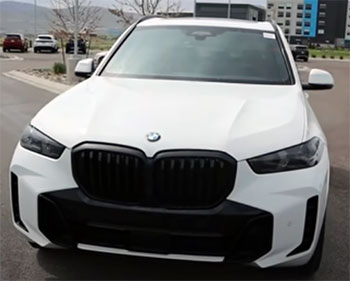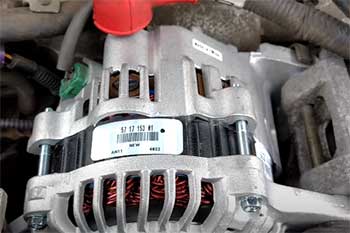I’ve always been drawn to BMW’s blend of luxury and performance, but choosing between the BMW X5 and its high-octane sibling, the X5M, felt like picking between a perfectly brewed coffee and an espresso shot with a turbo boost. Both are phenomenal midsize luxury SUVs, but they cater to different cravings.
In this article, I’ll take you through my experience exploring these two vehicles, breaking down their pros and cons, key features, and what makes each special. Whether you’re after comfort or adrenaline, I’ll help you decide which one fits your drive.
Comparison Table: BMW X5 vs. BMW X5M
| Feature | BMW X5 (xDrive40i) | BMW X5M Competition |
|---|---|---|
| Base Price | $68,000 | $129,700 |
| Engine | 3.0L Turbo Inline-6, 375 hp | 4.4L Twin-Turbo V8, 617 hp |
| 0-60 mph | 5.3 seconds | 3.7 seconds |
| Drivetrain | All-Wheel Drive (xDrive) | M xDrive (All-Wheel Drive) |
| Fuel Economy (MPG) | 23 City / 27 Hwy | 13 City / 18 Hwy |
| Cargo Space | 22.9–66 cu. ft. | 22.9–66 cu. ft. |
| Suspension | Standard Adaptive | Adaptive M Suspension Professional |
| Key Features | Curved Display, Highway Assistant | M Sport Differential, M Compound Brakes |
| Ride Comfort | Smooth, plush | Stiff, performance-focused |
| Target Driver | Luxury seekers, daily commuters | Performance enthusiasts |
My First Encounter with the BMW X5
The BMW X5 has been a cornerstone of the luxury SUV market since 1999, and sitting behind the wheel of the 2025 xDrive40i, I felt why it’s called a “Sports Activity Vehicle.” The cabin greeted me with a sleek, modern vibe—think high-quality leather, a panoramic sunroof, and a massive curved display that felt like a spaceship’s cockpit.
The 14.9-inch infotainment screen paired with a 12.3-inch digital gauge cluster was intuitive, though I had to tap through a few menus to adjust the climate control. It’s not perfect, but it’s purposeful, with Apple CarPlay and Android Auto standard, plus a wireless charger for my phone.

Under the hood, the X5 xDrive40i boasts a 3.0-liter turbocharged inline-six engine pumping out 375 horsepower.
It’s smooth, responsive, and paired with an eight-speed automatic that shifts like butter.
On a winding road near my home, the X5 handled corners with confidence, though it leaned more toward comfort than razor-sharp agility.
I clocked 0-60 mph in about 5.3 seconds—plenty quick for merging onto highways or passing slower traffic.
The ride was plush, soaking up bumps, though the optional 22-inch wheels transmitted some road imperfections. For daily driving, this felt like a palace on wheels, with enough space for my family’s groceries and sports gear.
The X5’s interior is a standout. With 40.7 inches of rear legroom, my kids had no complaints, and the 22.9 cubic feet of cargo space (expandable to 66 with seats folded) easily swallowed weekend luggage. Features like heated front seats, dual-zone climate control, and rain-sensing wipers come standard, but I was tempted by options like massaging seats and a Bowers & Wilkins audio system.
The new lane-change assist, activated by glancing at the side mirror, felt futuristic, though I’d need more time to trust it fully.
Pros of the BMW X5
- Balanced Performance: The 375-hp inline-six delivers a perfect mix of power and efficiency, with 23/27 MPG (city/highway). It’s quick without being overwhelming.
- Luxury Comfort: The cabin is spacious, quiet, and packed with premium materials. It’s ideal for long drives or family trips.
- Advanced Tech: The curved display, Highway Assistant, and standard driver aids like blind-spot monitoring make it a tech lover’s dream.
- Versatility: With ample cargo space and optional off-road packages, it’s ready for city streets or light trails.
- Value Proposition: Starting at $68,000, the xDrive40i offers a lot for the price compared to rivals like the Mercedes GLE or Porsche Cayenne.
Cons of the BMW X5
- Complex Controls: The infotainment system, while sleek, buries some functions in menus, and the climate control fans can be noisy.
- Pricey Options: Upgrades like massaging seats or premium audio add thousands to the bill. My test model neared $90,000 with extras.
- Not the Sportiest: It’s agile but doesn’t match the Porsche Cayenne’s handling or the X5M’s raw power.
- Large Wheels Impact Ride: The 22-inch wheels look great but can make the ride feel less smooth on rough roads.
Stepping Into the BMW X5M Competition

Then came the X5M Competition. If the X5 is a refined coffee, the X5M is a double espresso with a shot of adrenaline.
From the moment I saw its aggressive stance—wide kidney grille, sculpted bumpers, and quad tailpipes—I knew this was a different beast.
Inside, the cabin echoed the X5’s luxury but added M-specific touches: red M drive-mode buttons, carbonව
System: carbon fiber trim, and a sporty steering wheel with Alcantara grips. The 617-horsepower 4.4-liter twin-turbo V8 roared to life, and I was pushed back in my seat as it hit 0-60 mph in just 3.7 seconds. This thing is a rocket, with a top speed of 155 mph (177 with the M Driver’s Package).
On the road, the X5M felt like it was glued to the pavement. The Adaptive M Suspension Professional and M Sport Differential made corners feel effortless, though the ride was stiff—almost punishing on bumpy roads.
Sport mode sharpened the handling, but Comfort mode still felt too firm for daily driving. The brakes, with six-piston front calipers, were confidence-inspiring, though I noticed a slightly soft pedal feel at low speeds. The X5M’s 21-inch wheels and Michelin Pilot Sport 4S tires gripped like a race car, but the all-season tires on my test model made steering feel vague on highways.
The interior mirrored the X5’s spaciousness but dialed up the sportiness. The M-specific seats were firmer, designed for performance driving, but less plush for long trips. Cargo space matched the X5’s, but the lack of comfort access on rear doors was a minor annoyance. The X5M’s tech was identical to the X5’s, with the same curved display and driver aids, though adaptive cruise control costs extra—a surprising omission for a $129,700 SUV.
Read More: My Thoughts On Acura MDX Vs. Volvo XC90
Pros of the BMW X5M Competition
- Blistering Performance: The 617-hp V8 and 3.7-second 0-60 time make it one of the fastest SUVs on the market.
- Track-Ready Handling: The M xDrive system, M Sport Differential, and adaptive suspension deliver razor-sharp cornering.
- Bold Design: The aggressive styling, from the M kidney grille to quad tailpipes, turns heads everywhere.
- Luxury Meets Sport: It retains the X5’s premium interior with exclusive M touches like carbon fiber trim and red M buttons.
- Exclusive Features: The M Driver’s Package and optional high-performance driving course add track-day appeal.
Cons of the BMW X5M Competition
- Harsh Ride: The stiff suspension makes daily driving uncomfortable, especially on rough roads.
- Poor Fuel Economy: At 13/18 MPG, it’s a gas guzzler, and premium fuel isn’t cheap.
- High Cost: Starting at $129,700, it’s nearly double the X5 xDrive40i’s price, with options pushing it higher.
- Limited Practicality: It’s less comfortable for family duties due to firm seats and a harsh ride.
- Missing Features: Adaptive cruise control and lane centering aren’t standard, which feels stingy at this price.
Driving Dynamics: A Tale of Two Experiences

Driving the X5 and X5M back-to-back was eye-opening. The X5 xDrive40i felt like a trusted companion—smooth, composed, and versatile.
I took it on a weekend trip, and it handled everything from highway cruising to light gravel roads with ease.
The inline-six had enough grunt for quick passes, and the cabin’s quietness made long drives relaxing.
It’s the SUV you’d choose for a cross-country road trip with the family, balancing performance with comfort.
The X5M, however, was a thrill ride. On a twisty mountain road, it devoured corners with precision, the V8’s growl egging me on. But on my daily commute, the stiff ride and constant road noise from the tires wore me down.
It’s a car that begs to be pushed hard, ideally on a track, but for errands or school runs, it felt like overkill. I couldn’t help but think of a friend’s X5 M60i, which offered 90% of the X5M’s speed with a softer ride—potentially a better daily driver.
Technology and Safety: Shared Strengths, Some Gaps
Both SUVs share BMW’s cutting-edge tech, like the Curved Display and iDrive 8 system. The X5’s standard driver aids—blind-spot monitoring, lane-keeping assist, and automated emergency braking—worked seamlessly in my tests. The optional Highway Assistant allowed hands-free driving on highways, which was a game-changer for reducing fatigue.
However, the X5M’s lack of standard adaptive cruise control felt like a misstep for its price. Both models earned high safety ratings from the IIHS, with easy-to-use LATCH systems for child seats, though the X5’s rear seat felt slightly tighter than rivals like the Audi Q7.
Practicality and Comfort: Family vs. Fun
For family duties, the X5 shines. Its plush seats, generous legroom, and double rear hatch (which prevents groceries from spilling) made it a hit with my wife and kids. The X5M, while equally spacious, sacrifices comfort for performance.
The firmer seats and stiff ride drew complaints from my kids on longer trips. If you’re hauling kids and car seats, the X5’s softer suspension and plusher seats are the way to go. For solo drives or track days, the X5M’s raw power and handling are unmatched.
Cost and Value: Weighing the Price Tag
The X5 xDrive40i’s $68,000 starting price feels reasonable for its features and performance. It’s a strong value compared to the Mercedes GLE or Genesis GV80, especially with all-wheel drive standard. But the X5M’s $129,700 base price is a tough pill to swallow.
Yes, it’s faster than most SUVs, but the M60i ($96,245) offers similar thrills with better daily comfort. For most buyers, the X5’s balance of luxury and performance makes it the smarter buy, unless you’re chasing track-day bragging rights.
Who Are These SUVs For?
The X5 is for those who want a luxurious, versatile SUV that can handle daily life with a touch of sportiness. It’s perfect for families, commuters, or anyone who values comfort and tech. The X5M is for adrenaline junkies who crave supercar-like performance in an SUV package.
It’s a statement vehicle, but its stiff ride and high cost make it less practical for everyday use. I found myself loving the X5’s all-around appeal but dreaming of the X5M’s power on open roads.
Read More: My Thoughts On Acura MDX Vs. Lexus GX
Frequently Asked Questions (FAQ)
The “M” badge signifies BMW’s high-performance M division, indicating enhanced power, handling, and sporty design.
The X5 (e.g., xDrive40i) has a 375-hp inline-six, while the M50i (now M60i) offers a 523-hp V8, sportier suspension, and M styling, blending luxury and performance.
No, the X5M is still in production for 2025, with the Competition model offering 617 hp.
The X5M is a high-performance SUV with a 617-hp V8 and all-wheel drive, while the M5 Touring is a performance wagon with a 717-hp hybrid V8, lower stance, and sharper handling.
Conclusion: Your Drive, Your Choice
You’re at a crossroads with the BMW X5 and X5M. If you want a luxurious, comfortable SUV that handles family life and still delivers thrills, the X5 xDrive40i is your pick—versatile, tech-packed, and reasonably priced. But if you live for heart-pounding acceleration and track-ready handling, the X5M Competition will put a grin on your face, though it demands sacrifices in comfort and cost. I leaned toward the X5 for its all-around appeal, but the X5M’s raw power still haunts my dreams. Test drive both—you’ll know which one speaks to you.

